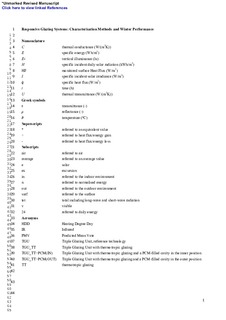Responsive glazing systems: Characterisation methods and winter performance
Journal article, Peer reviewed
Submitted version
Date
2017Metadata
Show full item recordCollections
Abstract
Responsive envelope components are promising technologies for improving the energy and indoor comfort performance of buildings. As far as the transparent envelope is concerned, several experimental and numerical researches have been carried out in recent years, focusing on the integration of Phase Change Materials (PCM) in glazing systems. To overcome some limitations highlighted during previous experimental campaigns, a new concept was prototyped, and the energy and comfort performance of a full-scale prototype was experimentally assessed in an outdoor test cell facility. In this paper, the focus is placed on the evaluation of the cold-season behaviour. The proposed glazing system comprises a triple-glazed unit with a PCM-filled cavity and a thermotropic glass placed on the outer side. The thermotropic glass acted as a switchable shading system capable of regulating the phase transition of the PCM by modulating the amount of solar radiation impinging on the PCM layer. The thermophysical and optical behaviour of the technology was monitored with the PCM alternately placed in the inner or the outer cavity of the triple-glazed unit and compared against a reference triple-glazing unit. In parallel to the measurements on the glazing with PCM and thermotropic glass, a triple-glazed unit equipped with a thermotropic glass was also monitored, giving a total of three different glazing systems under analysis. Representative days were selected in order to analyse the performance of the proposed technologies under significant and comparable boundary conditions. The equivalent thermal conductance of each technology was evaluated. The energy performance was assessed by means of both a long-term analysis and daily analyses on cloudy and sunny days. In addition, the visible transmittance of the three technologies was estimated through hourly measurements of vertical illuminance performed during a cloudy and a sunny day. Moreover, implications on thermal comfort conditions were evaluated ex-post by means of numerical simulations based on experimental data. The results showed that, during cloudy winter days, the position of the PCM did not influence the overall performance of the prototype since it never changed phase. On the other hand, during sunny winter days, the glazing with the PCM in the outer position underwent phase transition and presented a slightly better performance.
